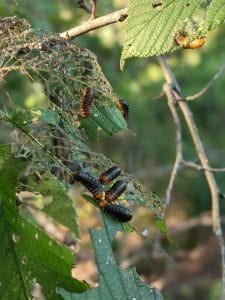First published by The Journal on August 29, 2022.
Last week a question came through the office about some trees that were suddenly losing all their leaves with no obvious explanation. My first thought was that it may be the work of the eastern tent caterpillar, which I have seen leaving large amounts of webbing on many deciduous trees this month. When large numbers are present, these caterpillars can fully defoliate trees. But the landowner indicated that there wasn’t any webbing on the trees they were concerned about. It sounded like a site visit was the way to go to pinpoint what was going on.
From a distance the trees certainly did look to be in sorry shape. Only a few crusty, brown, skeletonized leaves clung to the sizable trees’ branches. The ground crunched slightly below our feet, littered with dropped leaves. It was difficult to even identify the tree right away because the leaves were so damaged. But after a closer look, we found a cluster of large, serrated leaves still on the tree. They looked like elm leaves to me. Upon the leaves were many shiny, reddish-brown caterpillars munching away at the leaf tissue. An even closer look revealed that they were not caterpillars at all. They were actually beetle larvae.
There are two kinds of beetles that are known to defoliate elm trees specifically. They are the elm leaf beetle and the larger elm leaf beetle. As the names imply, one is larger than the other, but they have similar habits and life cycles. A quick comparison of larvae photos confirmed that the larvae we were seeing were that of the larger elm leaf beetle (Monocesta coryli). Interestingly, the elm leaf beetle is typically more destructive to elm trees in Ohio than the larger elm leaf beetle because the elm leaf beetle can produce two generations before winter, while the larger elm leaf beetle can only produce one generation.
While the extent of defoliation can be startling, late season feeding rarely causes long lasting harm to established trees. Beetle populations fluctuate from year to year. It is common to see one or two years of intense beetle pressure followed by many years of little to no noticeable damage. Weather patterns are likely related to beetle activity. Although a variety of commonly employed pesticides are effective on elm leaf beetles (both types), insecticide treatments are rarely justified to treat for these pests in residential or woodland locations.
The larvae that we saw feeding will eventually burrow into the soil where they will overwinter as grubs, pupate in the early spring, and emerge from the soil as adults in May. Adult beetles will feed on leaves and eventually lay clusters of yellow eggs on the undersides of leaves from which new larvae will hatch and begin to feed.
Adult larger elm leaf beetles are attractive looking insects. They are typically about a ½ inch long beetle, with golden-yellow wings that have dark blue, metallic, blotches across their wings, with orange heads, legs, and antennae. Although elm is their preferred host, larger elm leaf beetles may also feed on and be found near dogwoods, birch trees, hawthorns, and more. If you are noticing damage to elms like I have described, there is no need to panic. Your trees will very likely rebound from this condition next year without any assistance.
For help evaluating ailments of landscape plants in Noble County, you can consult with me by email (gelley.2@osu.edu) or on the phone at 740-732-5681. Site visits can be scheduled to further evaluate the situation if deemed necessary.
